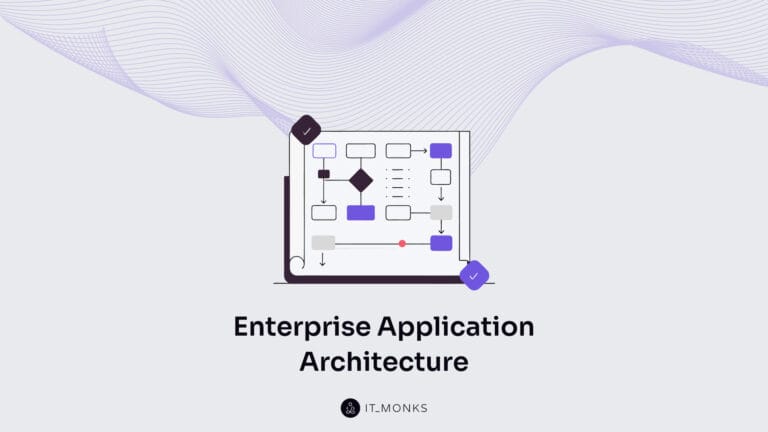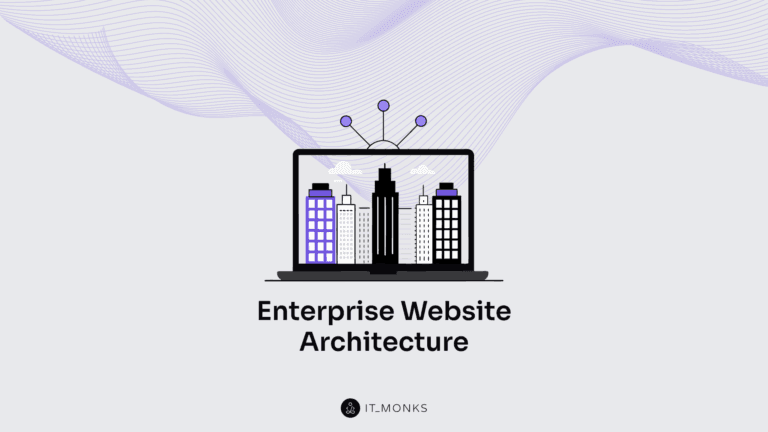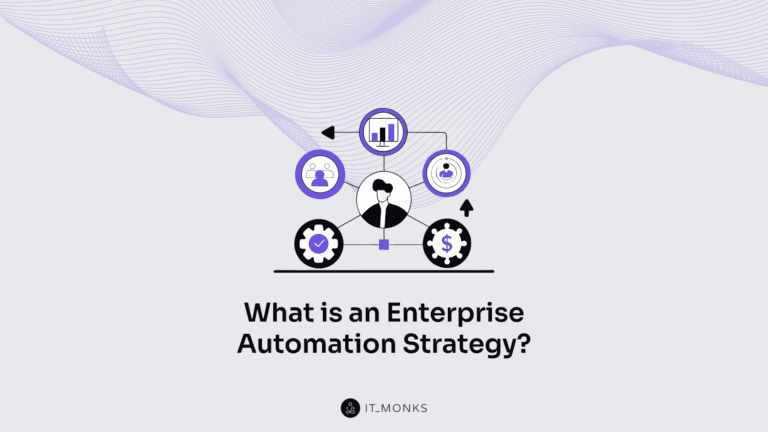Website Planning – Main Things to Consider
Table of Contents

The foundation of a successful online presence begins with meticulous website planning. But what exactly does website project management entail? It goes beyond a blueprint and deciding on the cost of a website launch; it’s a strategic roadmap that navigates through crucial stages, each with significance. This process is the backbone of a well-executed web presence, from defining objectives and target audiences to outlining features and functionalities.
This article delves into the intricacies of website planning, shedding light on the stages involved and deciphering their importance. Whether considering the DIY approach or entrusting the task to a professional web development company, understanding the nuances of each phase is imperative. Join us as we explore the key components of website planning, emphasizing its critical role in laying the groundwork for a thriving online business. After all, in web development, a well-thought-out plan is the key to unlocking success.
How to Plan a Website
Embarking on the journey of website planning requires a thoughtful approach. Before diving into the technicalities, it’s crucial first to establish why the website exists, who it serves, and the tasks it aims to accomplish. Below, we’ll outline the process IT Monks agency’s experts recommend when crafting a personalized web design.
Set Up Your Goals
To begin planning your website, start by outlining the objectives you aim to accomplish with your website. What are the reasons behind the (re)design of your website? Clearly define the precise goals for your website’s design or redesign project and how you intend to assess them.
If you currently have a functioning website, assess its performance and identify areas with potential for enhancement. Document specific SMART goals, which are Specific, Measurable, Attainable, Relevant, and Timely.
These objectives may encompass:
- Increasing website traffic
- Generating leads
- Enhancing online sales
- Reducing bounce rate
- Growing your email subscriber base
- Enhancing customer satisfaction
- Improving conversion rates
Define Your Unique Selling Proposition
In the process of planning a website, after establishing your goals, the next step involves developing marketing strategies to reach the audience and prompt them to take action. The initial stage in this process is crafting a unique selling proposition (USP).
So, what exactly is a unique selling proposition? The distinguishing factor sets your brand, products, or services apart from and/or above your competitors. It outlines the key selling points that motivate potential customers to take action and move closer to becoming your customer. It captures the attention of your ideal customers and is why they select your brand over others.
Understanding your USP is crucial in website planning, as your site will be centered around your unique selling points. All your copy and content will be strategically positioned to subtly (and at times, not so subtly) promote your USP and convey to website visitors why they should choose your brand.
To develop your unique selling proposition, consider your brand, products, and services and address the following questions:
- How do you differentiate yourself from your competitors?
- Why does that differentiation matter to customers?
- What specific benefit do customers gain by choosing you over the competition?
- Why does that benefit matter to customers?
Take your time with this exercise. The immediate thoughts that come to mind may be too obvious. Dedicate time to truly delving into how your offerings genuinely assist your customers and address their problems.
Additionally, if you’re struggling to identify your unique selling proposition, consider these tips for guidance:
- Reflect on what your customers value and how you assist them in obtaining those things.
- Contemplate the issues your customers encounter and how you aid in resolving them.
- Evaluate the distinctive strengths your brand brings to the table.
- Analyze your competitors to see how you can distinguish your brand.
It’s important to note that unique selling propositions are not exclusive to eCommerce sites and service-oriented businesses. Even as a content creator or blogger, where you’re “selling” information and aiming to establish yourself as a thought leader, these questions remain relevant. What are you doing to set yourself apart from the crowd?
Define Your Target Audience
Developing personas for your target audience is beneficial to gaining a deeper understanding of your users’ needs and expectations. Consider including various details such as gender, age, education, marital status, professional background, frustrations, needs, expectations, likes/dislikes, approach to website planning, corporate subscriptions, personal traits, preferences, pain points, and anxieties. Creating user personas will enable you to view your website from the perspective of your users, helping to clarify messaging, user journey, and design requirements.
Competitors Analysis
Take a thorough look at your top competitors by analyzing the following aspects:
- Sitemap
- Content strategy
- Messaging
- Key landing pages
- SEO efforts (utilize tools like SEOMinion and Ahrefs to assess title tags, meta descriptions, image titles, etc.)
The main goal is to evaluate your competitors’ strengths and weaknesses compared to your own business, identify market gaps, and enhance your overall strategy.
Discuss your competitors’ offerings, highlight the points of differentiation from your offerings, and identify what makes them appealing to customers.
Website Project Management
These preparatory steps lay the foundation for the entire website. Now, delve into the technical planning phase. While navigating these intricacies independently is possible, partnering with professionals ensures a comprehensive approach, seamlessly addressing technical complexities.
Website Planning With Web Developer Company
Planning a website can be exciting, and partnering with a web developer company can make all the difference. Let’s explore the key aspects of website planning and how working with a professional team can bring your vision to life. We’ll cover everything from defining your goals to creating a user-friendly interface.
Website Development Project Plan
This is the fundamental stage of website development planning, determining the cost of building a small business website and a large corporate portal. Well-developed planning phases will take roughly 30 hours at minimum, including all the meetings, project management, scheduling, and research. The larger the overall project, the more hours can be expected.
Website Discovery Phase
Total spent: 10 hours
This phase is obligatory for every project and is valuable to the practical and fruitful cooperation between you and your website development vendor. It includes:
- Kick-off Meeting marks the initiation of the website discovery phase. It involves gathering key stakeholders, including the client, project managers, designers, developers, and other relevant parties. The primary goal is to align everyone on the project’s objectives, expectations, and constraints. It sets the tone for communication, establishes roles and responsibilities, and ensures a shared understanding of the project’s purpose.
- The Setup phase involves creating the necessary infrastructure and environment for the website discovery process. This includes setting up communication channels, collaboration tools, and project management systems. It may also involve creating a timeline, allocating resources, and defining milestones for the project.
- Competitor analysis involves researching and evaluating competitors’ websites in the same industry. This includes assessing their design, functionality, content, user experience, and overall online presence. The goal is to identify strengths, weaknesses, opportunities, and threats that can inform the development of a unique and competitive website.
- General industry research goes beyond competitors and delves into broader trends, market demands, and user behavior within the industry. This phase involves studying relevant data, reports, and industry publications. It helps gain a comprehensive understanding of the target audience, emerging technologies, and evolving preferences within the industry.
Website Strategy
Total spent: 10 hours
The strategy for building a small business website (as well as a large corporate project) is made in a deliverable document containing all the information, associated templates, and tools. Typically, it will take about 8 to 12 hours to set up a strategy to build a website from scratch or update an existing project. Still, it can vary with additional requested strategy elements such as content marketing or social media. It covers:
- User Research involves gathering data and insights about the target audience. This includes understanding their needs, preferences, behaviors, and pain points. It often involves surveys, interviews, and analytics tools to collect relevant information. The aim is to create a user-centric website that meets the expectations and requirements of the intended audience.
- Content strategy involves planning and organizing the content that will be presented on the website. This includes defining the target audience, creating a content calendar, determining the tone and style of the content, and outlining the key messages. It ensures that the content aligns with the brand, engages the audience, and supports the overall goals of the website.
- Conversion strategy focuses on turning website visitors into customers or achieving other desired actions (e.g., sign-ups, downloads, inquiries). It involves the optimization of calls-to-action (CTAs), user flows, and other elements to encourage desired user behaviors. Analytics tools are often used to track and measure the effectiveness of the conversion strategy.
- A content template is a structured document that outlines the format, layout, and elements of different types of content on the website. It serves as a guide for creating consistent and visually appealing content. The template may include sections for text, images, videos, and other media and guidelines for maintaining a unified brand voice and style.
SEO Strategy and Setup
Total spent: 15-20 hours
This stage of website development planning can vary by the importance of SEO for a client, the number of products and services offered, and planned future use for the website. The total hourly range could be from a low of 20 hours to a high of 70.
- Keyword analysis involves researching and identifying keywords and phrases that potential users might use when searching for products, services, or information related to the website. This analysis helps understand the target audience’s search intent and guides content creation and optimization efforts.
- In the context of SEO, content strategy involves planning the creation and organization of website content to align with targeted keywords. It includes developing a content calendar, deciding on the types of content to create, and ensuring that content is valuable and relevant to the audience.
- Meta title and meta description optimization. Meta titles and meta descriptions are HTML tags that provide concise information about a web page’s content. Optimization involves strategically incorporating target keywords, writing compelling and descriptive titles, and creating engaging meta descriptions encouraging users to click through to the website.
- Configure Google Search Console & Schema markup. Google Search Console is a tool that helps website owners monitor, maintain, and troubleshoot their site’s presence in Google Search results. Schema markup is a structured data format that helps search engines understand the content on a webpage better. Configuring involves setting up accounts, verifying ownership, and implementing schema markup to enhance search engine understanding.
- Google Analytics install. Google Analytics is a web analytics service that tracks and reports website traffic. Installing Google Analytics involves adding a tracking code to the website, enabling data collection on user behavior, demographics, and more.
- 301 redirect old pages to new. When redesigning or updating a website, it’s common to change URLs. Implementing 301 redirects ensures that traffic from old URLs is redirected to the new ones. This is crucial for preserving SEO value, preventing broken links, and maintaining a positive user experience.
The Website Development Project Plan encompasses three crucial phases – Website Discovery, Website Strategy, and SEO Strategy and Setup. These phases collectively require a total time investment of 30 to 40 hours.
Website Plan Practical Implementation
Total spent: ~100-120 hours
This part of the website development planning is the most prolonged and complicated. This could be around 100-120 hours on a typical SMB-sized website but can be opt-in in any way as far as possible.
- Usually, all the main pages are done in stages as well – firstly, all design and mockups are done, and secondly, you move to web development. The header, footer, and cross-cut elements ensure a cohesive and navigable structure across all website pages, maintaining consistent branding and facilitating user-friendly navigation. The main page, typically the homepage, is the initial point of contact, requiring effective design to communicate the brand’s identity and highlight key offerings. Custom page builder settings, if needed, enable easy content updates and scalability for future growth. The About Company page establishes trust by providing detailed information about the organization’s history, mission, and team. Service or Product Pages, including an index and sub-pages, focus on a clear and persuasive presentation to showcase offerings. The Contact Page, with a form or contact details, encourages user engagement and inquiries. Collectively, these elements contribute to a well-designed, functional website that effectively communicates brand identity and offerings.
- Other Pages Considered Core (Careers Page, Case Study / Projects (Index and Individual Pages), Blog Index and Posts, FAQ, Events, Why Us). While not classified as core, these pages contribute valuable content, information, and engagement opportunities. They enhance the overall user experience and may be essential based on the business’s needs and goals.
- Technical Pages (404 Page, Thank You Page for Conversion Tracking). The 404 page addresses user errors by providing a friendly error message, and the Thank You page is crucial for tracking conversions and expressing gratitude to users who have completed the desired actions.
Add On Website Functionality
The Core Website wouldn’t have any specific solutions, for example, third-party integrations with CRM or ERPs. Keep in mind the additional development hours in the total project budget for any add-ons, plugins, and custom functionality like:
- Pop-ups are interactive elements that appear over the website content. They can be used for various purposes, such as capturing leads, promoting offers, or providing important announcements.
- A gallery displays images or multimedia content in an organized and visually appealing manner. It is commonly used to showcase portfolios, products, or visual storytelling.
- Integrating social media feeds directly onto the website allows real-time display of social media posts and activities. This fosters social proof and keeps content fresh.
- Multilingual functionality enables the translation of website content into multiple languages. Users can switch between languages for a more personalized experience.
- Logo carousels showcase a rotating display of logos, often featuring partners, clients, or certifications. It adds a dynamic element to the website.
- A mega menu is an expanded, multi-column navigation menu that provides a structured and efficient way to navigate through a large volume of content.
- Importance: Enhances navigation for websites with extensive content, improving user experience.
- An internal site search feature enables users to search for specific content within the website. It enhances user experience by facilitating quick access to information.
- Integrating Customer Relationship Management (CRM) and Enterprise Resource Planning (ERP) systems allows seamless data exchange between the website and business systems.
Website Content Development Plan
Total spent: ~10-20 hours
Content Development is not part of the website development planning but must be done during the web development stage. These services can be provided by either the client part, the web agency, or a contracted third party.
In a perfect scenario, the client should be involved in the content development project, and all the Content has to be provided before the Web Development Stage. In the real world, these processes are paralleled so web agencies can also be involved in content development.
SEO Copywriting
Total spent: ~3-5 hours per page
SEO copywriting is an essential component of website planning and development due to its unique focus on optimizing content for search engines. Unlike conventional writing, SEO copywriting involves crafting text that engages and informs the audience and strategically incorporates relevant keywords to enhance search engine visibility. The primary purpose of SEO text is to improve a website’s ranking in search results, making it more discoverable to users searching for specific information, products, or services. The distinction lies in deliberately integrating keywords, meta tags, and other SEO elements, ensuring that the content aligns with search engine algorithms.
The advantages of including SEO copywriting in website planning are multifaceted.
- Firstly, it enhances organic visibility, driving more targeted traffic to the website. By aligning with the language and intent of search queries, SEO text increases the likelihood of the website appearing on the first page of search engine results, where users are likelier to click.
- Additionally, SEO copywriting contributes to a positive user experience by delivering relevant and easily digestible content.
In the context of the provided statement, a skilled SEO copywriter can efficiently complete the optimization of non-article pages within 3 to 5 hours, including necessary revisions. It is crucial to involve a reliable copywriter from the project’s inception to avoid delays in the website launch. By doing so, the website can be strategically crafted with search engine optimization in mind, ensuring that content is compelling and strategically positioned to rank well in search engine results. Ultimately, integrating SEO copywriting in website planning is an investment in the website’s long-term success, driving organic traffic and improving overall online visibility.
Uploading or Migrating of the Content
Total spent: ~40 hours
The step of “Uploading or Migrating Content” is a crucial aspect of website planning, encompassing the transfer of content onto a new website or the migration of existing content from an old website. This process is allocated approximately 40 hours, with the actual time-varying based on content volume, complexity, and the method chosen for execution—either manual uploading or automated migration.
Content uploading involves manually inputting each piece of content onto the new website. A Content Manager or a designated team member typically performs this task. While manual uploading allows for meticulous control over the placement and formatting of content, it requires more hours due to the process’s hands-on nature.
On the other hand, migration involves transferring content from an old website to a new one, streamlining the transition. The choice between manual uploading and automated migration depends on factors like the website’s complexity, the volume of content, and the desired level of customization.
Including content uploading or migration in the website planning phase is essential. First, it ensures a seamless transition of information, preventing data loss and maintaining consistency. Second, it contributes to the overall efficiency of the website launch, as content availability is vital for providing a complete user experience. Moreover, proper planning for content migration helps identify potential challenges, allowing the team to allocate resources effectively and minimize disruptions during the website launch.
E-commerce Website Development Project Plan
Total spent: ~60-80 hours
For those venturing into developing an e-commerce website, it is imperative to underscore the critical importance of meticulously planning every facet of the project. Unlike conventional websites, e-commerce platforms involve intricate functionalities, such as secure payment gateways, comprehensive product catalog management, and real-time inventory tracking. This complexity necessitates a thorough project plan that leaves no stone unturned. The success of an e-commerce venture hinges on user experience, making it imperative to chart out the user journey, ensuring seamless navigation and a frictionless checkout process. Inadequate planning in this domain can result in dissatisfied customers and lost business opportunities.
Moreover, the vigilance of search engines towards e-commerce websites accentuates the need for a well-thought-out plan. Search engine optimization (SEO) is paramount for the visibility and success of an e-commerce platform. A meticulously planned project can include strategies for optimizing product pages, fine-tuning URL structures, and adhering to SEO best practices. Search engines prioritize user experience and relevance; thus, a comprehensive plan can help craft an SEO-friendly website architecture that enhances rankings. The intricate interplay between functionality, user experience, and SEO sensitivity underscores the unique challenges of e-commerce website development, making it imperative for developers to approach the project with heightened attention to detail and strategic planning.
E-commerce functionality is one of the most significant additional tasks to do. The estimated hours can vary dramatically and depend heavily on which CMS platform is used and the product catalog size – usually, it’s around 70-100 total hours. Notice that this is always additional to the Core Pages budget:
- General store setup
- Payment methods setup
- Shipping Configuration
- Order testing
- Product category page
- Product post
- Products compare
- Up-sell on checkout
- Connecting store to 3rd party software (fulfillment centers, CRMs, email platforms, referral programs)
Quality Assurance Plan For Website Development
Total spent: ~20-30 hours
Some clients must pay more attention to this stage and go directly to the Website Launch. But it’s better to discover all the problems at this stage than to find and fix them.
This process ensures that your website functions properly on different browsers and devices. And it’s a short process – a general guideline is to allocate 20-30% of the total development hours for quality assurance testing and revision.
Allocating enough time and budget for this step is crucial because it often requires extensive communication between the agency and your company. This is particularly true if multiple stakeholders are involved in the project, such as executives, sales teams, business partners, and consultants.
Website Launch
The Website Launch process is a nuanced and meticulous endeavor extending well beyond clicking a button. It is not a momentary action but a comprehensive process that typically requires 5 to 10 hours of dedicated effort. This timeframe indicates the intricate tasks ensuring a successful and smooth launch. It is common practice to strategically plan the launch at the beginning of the week, allowing for a buffer period to address and rectify any unforeseen issues promptly.
The launch process encompasses several critical steps, each demanding careful planning and execution. This includes initiating communication to obtain hosting credentials, facilitating the seamless transition from the staging site to the production environment, conducting basic testing on the production server, and configuring 301 redirects. The latter is particularly crucial as it ensures the smooth migration of users from old website pages to new ones, preserving the website’s search engine optimization (SEO) integrity.
Furthermore, tasks such as changing the Domain Name System (DNS) settings to point the website domain name to the new server, submitting the sitemap to Google Search Console for immediate indexing, installing SSL security for data protection, and setting up a Content Delivery Network (CDN) for optimized content delivery are integral components of the launch process. Each task demands attention to detail and a strategic approach to ensure a flawless transition from staging to production and safeguard the website’s performance, security, and SEO standing.
The Website Plan Practical Implementation, which requires approximately 100-120 hours, is crucial for successful website development. It involves core page creation, additional content, technical pages, and considerations for add-on functionalities. E-commerce development demands meticulous planning for complex features, estimating 60-80 hours. SEO Copywriting enhances organic visibility with 3-5 hours per page. The Quality Assurance Plan, with 20-30 hours, ensures a flawless user experience. In essence, this phase is vital for a well-planned and executed website.
Conclusion
Meticulous website planning is foundational for a thriving online presence, addressing crucial stages from goal-setting to user-centric design. Whether opting for a DIY approach or seeking professional guidance, understanding each phase is essential. For expert assistance in website planning and launch, trust the IT Monks Agency. Their experienced team navigates technical complexities seamlessly, ensuring comprehensive strategies. The agency excels in delivering successful projects from website discovery to quality assurance. If you aspire to unlock the full potential of your online venture, rely on the IT Monks Agency for professional support in crafting and launching a strategically planned website.
FAQ
- How to plan a website development project?
Planning a website development project involves setting clear goals and objectives and utilizing the SMART criteria for precision and effectiveness. Craft a Unique Selling Proposition (USP) that distinguishes your brand, products, or services, emphasizing key selling points that motivate customer action. Define your target audience through detailed personas, considering demographics, preferences, and pain points. Conduct a thorough competitor analysis to identify strengths, weaknesses, and market gaps. Collaborate with professionals, such as a web development company, for a comprehensive approach that ensures a successful project outcome.
- How to develop a website plan?
To develop a website plan, initiate the Website Discovery Phase, including a kick-off meeting to align stakeholders and competitor analysis. Formulate a Website Strategy encompassing user research, content strategy, and conversion strategy, with a focus on SEO and a content template. Implement SEO copywriting to optimize content for search engines, enhancing organic visibility and user experience. Ensure content development is a parallel process involving the client or third party, with content ready before the web development stage. Dedicate a substantial portion of development hours to Quality Assurance, ensuring a flawless user experience. Execute a meticulous Website Launch process, covering tasks from DNS settings to SSL installation, over 5-10 hours for a successful and seamless transition from staging to production.
Contact

Send a Project Brief
You are currently viewing a placeholder content from Facebook. To access the actual content, click the button below. Please note that doing so will share data with third-party providers.
More InformationYou are currently viewing a placeholder content from Instagram. To access the actual content, click the button below. Please note that doing so will share data with third-party providers.
More InformationYou are currently viewing a placeholder content from X. To access the actual content, click the button below. Please note that doing so will share data with third-party providers.
More Information


